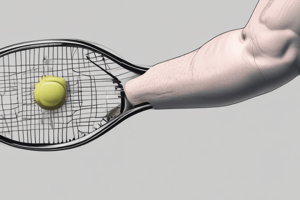Podcast
Questions and Answers
Tenisçi dirseğinin ana nedeni nedir?
Tenisçi dirseğinin ana nedeni nedir?
- Dirsek eklemindeki aşırı hareketler
- Dirsek eklemindeki kemik çıkıntısı
- Dirsek eklemindeki tendon hasarı (correct)
- Dirsek eklemindeki şişlik
Tenisçi dirseğinin en yaygın semptomları nelerdir?
Tenisçi dirseğinin en yaygın semptomları nelerdir?
- Dirsek ekleminde ağrı ve güçsüzlük (correct)
- Dirsek ekleminde şişlik ve kızarıklık
- Dirsek ekleminde yanma hissi
- Dirsek ekleminde hareket kısıtlılığı
Hangi aktiviteler tenisçi dirseğine neden olabilir?
Hangi aktiviteler tenisçi dirseğine neden olabilir?
- Sadece bahçe işleri yapmak
- Ev işleri, bahçe işleri, spor ve müzik gibi çeşitli aktiviteler (correct)
- Sadece tenis oynamak
- Sadece çalgı çalmak
Tenisçi dirseği için en yaygın tedavi yöntemi nedir?
Tenisçi dirseği için en yaygın tedavi yöntemi nedir?
Tenisçi dirseğinin en önemli risk faktörü nedir?
Tenisçi dirseğinin en önemli risk faktörü nedir?
Tenisçi dirseği tedavisinde hangi yöntem en son başvurulan seçenektir?
Tenisçi dirseği tedavisinde hangi yöntem en son başvurulan seçenektir?
Tenisçi dirseği tedavisi için, fizik tedavi seansları genellikle hangi alanlara odaklanır?
Tenisçi dirseği tedavisi için, fizik tedavi seansları genellikle hangi alanlara odaklanır?
Kortikosteroid enjeksiyonları ne için kullanılır?
Kortikosteroid enjeksiyonları ne için kullanılır?
Tenisçi dirseği cerrahisi hangi durumda genellikle tercih edilir?
Tenisçi dirseği cerrahisi hangi durumda genellikle tercih edilir?
Nonsteroidal anti-inflamatuar ilaçlar (NSAID'ler) ne için reçete edilir?
Nonsteroidal anti-inflamatuar ilaçlar (NSAID'ler) ne için reçete edilir?
Tenisçi dirseği oluşumunu önlemek için neler yapılabilir?
Tenisçi dirseği oluşumunu önlemek için neler yapılabilir?
Kortikosteroid enjeksiyonlarının aşırı kullanımının olası sonucu nedir?
Kortikosteroid enjeksiyonlarının aşırı kullanımının olası sonucu nedir?
Flashcards are hidden until you start studying
Study Notes
Tennis Elbow: A Comprehensive Guide
Tennis Elbow: Definition and Causes
Tennis elbow, medically known as epicondylitis lateralis humeri, is a painful condition that affects the outside of your elbow joint. It occurs due to damage to the tendons that attach muscles to the bone on the lateral side of the elbow, resulting from repetitive motions involving the wrist, forearm, and elbow. This type of injury most commonly happens during sports like tennis but can also occur with other activities such as painting, gardening, playing a musical instrument, or even doing the dishes.
Structure of Tennis Elbow
Tennis elbow occurs when the tendons on the lateral epicondyle become inflamed and damaged due to repetitive actions involving the wrist, forearm, and elbow. The primary symptoms include pain and weakness on the outside of your elbow joint that can spread down to your hand and forearm. Although the injury is named after tennis players, many people who are not athletes have been found to suffer from this condition due to daily activities requiring forceful gripping or repetitive movements.
Treatment Options for Tennis Elbow
Conservative Management
Treatment for tennis elbow typically involves rest, avoiding the activity causing the problem, and wearing a brace or splint to protect the affected area. Pain relief medication like nonsteroidal anti-inflammatory drugs (NSAIDs) may be prescribed, but they should only be used temporarily because prolonged use could lead to further damage.
Physical Therapy and Exercise
Physical therapy sessions often focus on exercises to strengthen muscles and improve flexibility around the shoulder and elbow joints. These therapies help reduce tension in the injured areas and improve overall pain management.
Corticosteroid Injections
If symptoms do not improve with conservative treatment, corticosteroid injections may be considered to reduce inflammation and relieve pain. However, these should only be used occasionally because overuse may lead to thinning of the skin and soft tissue and could potentially cause an infection.
Surgery
Surgery is generally a last resort when all other treatments have failed to bring relief within six months or if there are signs of nerve compression. The surgery involves removing damaged tissue around the lateral epicondyle to provide more space for blood vessels and promote healing and recovery.
Prevention Strategies for Tennis Elbow
To prevent tennis elbow, it's essential to maintain proper technique when using tools or equipment, avoid putting excessive strain on your wrist and forearm muscles, and strengthen your shoulder and upper arm muscles through regular exercise. Additionally, taking frequent breaks while performing tasks that require forceful gripping can help lower the risk of developing this condition.
By understanding the causes, structure, and available treatments, you are better equipped to recognize and manage tennis elbow, ensuring a speedy recovery and preventing future episodes.
Studying That Suits You
Use AI to generate personalized quizzes and flashcards to suit your learning preferences.




